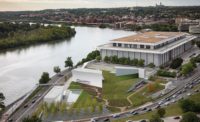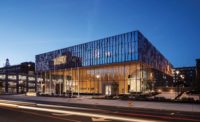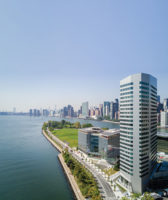Though many associate the peninsula of Charleston, South Carolina, with its southernmost tip and its dense streets of magnificent 18th- and 19th-century houses, there is more to the city’s story. Moving northward, things get a bit funky. Here, historic homes and churches and Marion Square give way to less noteworthy features, like swaths of surface parking, gas stations, and a crenelated Embassy Suites. Yet within this unprepossessing context, a lone midcentury office building has been transformed into a stylish 100,000-square-foot, 155-room hotel called the Dewberry.
The former L. Mendel Rivers Federal Building, designed by the now defunct South Carolina firm Lyles, Bissett, Carlisle and Wolff, was built in 1964 to house various government agencies. Modern and Minimalist, it was constructed in accordance with 1962’s Guiding Principles for Federal Architecture, which charged buildings to “reflect the dignity, enterprise, vigor and stability of the American Government” and incorporate elements that reflect regional design traditions. The facility closed in 1999, after sustaining damage from Hurricane Floyd.
Additional Content:
Jump to credits & specifications
The driving force behind its reinvention is John Dewberry, an Atlanta-based developer with a portfolio of mid- and high-rise commercial and residential buildings. A former Georgia Tech quarterback, he is a larger-than-life personality with an unstoppable drive. When Dewberry, who has a home in Charleston, bought the concrete-and-steel-structure brick building from the GSA in 2008, he saw it as the perfect canvas for creating a luxury hospitality brand. In line with the Guiding Principles, Dewberry hoped for his hotel to retain its civic dignity while capturing the spirit of the Lowcountry. “My idea,” he says, “was to give a nod to Midcentury Modern, but I wanted the hotel to be about Charleston as well.” While the developer decided to name the property after his father—who died while the project was ongoing—it does double, of course, as his namesake too.
Soon after the purchase, Dewberry assembled his design team: local architect Reggie Gibson—whose proposal was a departure in its intent to preserve rather than raze the building, as many in the community wished—and Lockie Brown, now of StudioDewberry, Dewberry Capital’s in-house design group, which the developer formed as the project progressed, to retain more control. For interiors, Dewberry turned to Workstead Studio, the Brooklyn-based design team behind the public spaces in that borough’s Wythe Hotel (the firm has now opened an office in Charleston). An eight-year-long process of design, financing, procuring permits, and extensive asbestos abatement followed.
The building exterior today remains largely unaltered, save for a ballroom the team appended to its back and a glass box they erected on the roof for a lounge and events space, surrounded by a roof deck with 360-degree views out to the peninsula and the Ashley and Cooper rivers converging in the harbor. The seventh level, just below the roof, originally housed mechanicals but has been transformed into a floor of guest rooms. These moves were necessary, Dewberry says, to make the economics work but also, he remarks of the building, “We thought that she was a little fat, and we needed to lift her up a bit.”
Another significant change was to push the glazing back from the colonnade at one end, creating a porch—a requisite of Southern living—that wraps the spacious ground-floor lounge dubbed the “Living Room.” The team saw the protruding white marble window surrounds (patterned after a nearby historic building) as the structure’s most redeeming quality, but felt they were undermined by the original red brick. One of the more controversial moves was to lime-wash the building, say Gibson and Brown, sparking a battle with the city and neighbors. The fight was worth it, and the handsome dusty gray lends a sober but also light formality and calls out the veining in the marble elements. The lime-washed-stucco treatment of the structure’s base, however, lacks the solidity of the rest of the building and is the exterior’s weak moment.
Inside, while the team kept the elevator and stair core in place, the rest of the floor plans were completely reworked. Finding that 10 years of neglect had taken its toll on finishes, very few were salvaged. Now, beneath a new lead-coated copper canopy, guests enter a small lobby with white Vermont Danby marble floors (the old marble was made into tabletops for the outdoor café) and cherry-paneled walls with unlaquered brass trim. This space leads into a brasserie-like restaurant, the elevator bank, and the spacious Living Room, which is divided into zones by the careful placement of artwork and both new and Midcentury furnishings and light fixtures (many of the pieces purchased at auction), so the space has a comfortable, domestic feel. Stefanie Brechbuehler and Robert Highsmith of Workstead call the aesthetic “Southern modernism,” and it resonates in the selection and custom design of furnishings, lighting, and soft goods. On the upper floors, the team transformed warrens of offices into double-loaded corridors, pleasantly low-lit, that lead to the smartly furnished guest rooms. With their marching rows of tall, narrow windows, the rooms carry a reminder of the building’s former life.
On a recent tour, Dewberry expounded on his vision for the project and his personal investment in the design, construction, fit-out, and branding. The developer hopes to build on the name internationally, starting with multifamily housing on the hotel’s adjacent parking lot. Clearly, he has a knack for assembling a team that can make it all happen. The design instinct apparent here through the deft exploitation of an existing building’s assets, and an obsession with detail, have combined to create a hotel that stands out as an unlikely new tourist destination in this historic city.
CreditsArchitect: McMillan Pazdan Smith Architecture (Architect of Record)— 121 Calhoun St, Charleston, SC 29401, (843) 566-0771, mcmillanpazdansmith.com Reggie Gibson Architects (Design Architect)— 12 Vanderhorst St # B, Charleston, SC 29403, (843) 722-9040, reggiegibsonarchitects.com Lockie Brown of StudioDewberry (Design Architect)—1545 Peachtree Street, Suite 250, Atlanta, GA 30309, (404) 888-7990, dewberrycapital.com (*Note, this website is due to change by print date)
Personnel in architect's firm who should receive special credit: Reggie Gibson Joseph M. Pazdan, II, AIA Eric Garris, AIA Alfonso A. Abate, AIA Lockie Brown, AIA
Architect of record: McMillan Pazdan Smith Architecture (Architect of Record)— 121 Calhoun St, Charleston, SC 29401, (843) 566-0771, mcmillanpazdansmith.com
Associate architect(s): Reggie Gibson Architects (Design Architect)— 12 Vanderhorst St # B, Charleston, SC 29403,(843) 722-9040, reggiegibsonarchitects.com Lockie Brown of StudioDewberry (Design Architect)—1545 Peachtree Street, Suite 250, Atlanta, GA 30309, (404) 888-7990, dewberrycapital.com (*Note, this website is due to change by print date)
Interior designer: Studio Dewberry Workstead
Engineers: Civil: Forsberg Engineering & Surveying, Inc.-Charleston, SC Structural: 4SE, Inc. – Charleston, SC Mechanical, Electrical: PROMUS Engineering- Atlanta, GA Plumbing: Promus Engineering- Atlanta, GA Landscape Architect: DesignWorks,LC – Charleston, SC
Consultants: Lighting: BOLD, Brian Orter – New York, NY AV/Systems: ETI, Mark Mitchum –Atlanta, GA
General contractor: McCrory Construction Company – Columbia, SC Dewberry Capital – Atlanta, GA
Photographer: Kris Tamburello |
SpecificationsExterior Cladding Marble: Original from 1963. Believed to be Georgia marble like Federal Reserve in Atlanta.
Roofing Other: Architectural Metal Work
Windows Metal frame: Old Castle Reliance Storm Max
Glazing Glass: PPG
Doors Entrances: Dorma Revolving Doors Sliding doors: FGD Glass Solutions Fire-control doors, security grilles: U.S. Smoke & Fire- Smoke Curtains
Hardware Locksets: Rocky Mountain/Safelok
Interior Finishes Cabinetwork and custom woodwork: Specialty Woodworks, Inc, Charleston Woodworks, Perrin Woodworking Floor and wall tile: Vermont Marble- Danby Carpet: Shaw – custom design: Special interior finishes unique to this project: Opuzen with custom art by Becca Barnet, custom hand painted paneling by Thomas Swanston, custom brass install by Peyton Avrett.
Furnishings Other furniture: Public Space Furniture: Studio Dewberry curated period pieces- Westwood Avenue Hospitality Custom upholstered pieces and Stickley case goods and Lawson-Fenning and Michel FERRAND.
Lighting Tasklighting: Urban Electric, Workstead Lighting, Woka Lighting, Robert Long Exterior: Lumascape
Conveyance Elevators/escalators: Otis Elevators
Plumbing Faucet Sets: Newport Brass Toilets: Toto Lavs: Kohler
Energy Add any additional building components or special equipment that made a significant contribution to this project: Daikin VRF System, AON- Energy Recovery |














